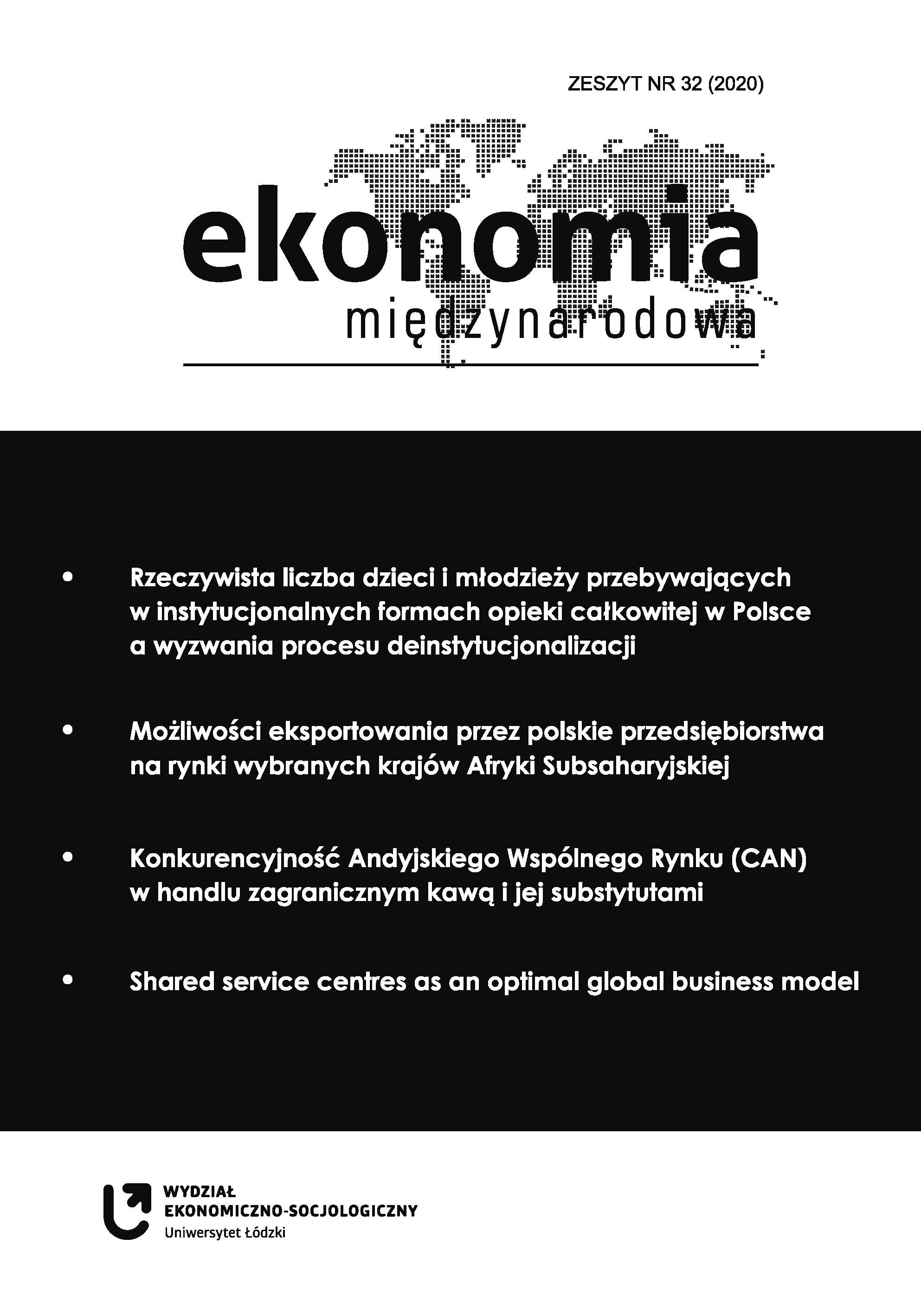Centra usług wspólnych jako optymalny model biznesowy dla korporacji o zasięgu globalnym
DOI:
https://doi.org/10.18778/2082-4440.32.04Słowa kluczowe:
księgowość, finance, księga główna, globalny model biznesowyAbstrakt
W świecie globalnych korporacji outsourcing części usług biznesowych zyskał na popularności na przestrzeni ostatnich 20 lat. W obszarze zarządzania finansami dominują ograniczenia legislacyjne, za którymi korporacje globalne bezwzględnie muszą podążać, co generuje wysokie koszty obsługi finansowo-księgowej.
Wydaje się, że umiejętność zarządzania strategicznego pozwoli globalnym gigantom pozostać konkurencyjnymi pomimo rosnących regulacji, a za tym rosnących kosztów. Nowy model biznesowy jest zdeterminowany znaczącym ograniczeniem kosztów z jednej strony oraz wysoką jakością usług z zakresu finansów i księgowości z drugiej strony; co jest możliwe dzięki określonym zmianom w strukturze organizacji o globalnym zasięgu. Celem niniejszego artykułu jest wskazanie jak określony, przyjęty przez organizację model biznesowy determinuje zarządzanie korporacyjnymi finansami oraz jak powyższe wpływa na zmianę struktury organizacyjnej korporacji o zasięgu globalnym. Artykuł ten jest próbą uchwycenia nowego trendu wśród korporacji międzynarodowych, polegającego na tworzeniu prawnie odrębnych, ale powiązanych kapitałowo jednostek organizacyjnych dla celów związanych z zarządzaniem finansami i rachunkowością.
Bibliografia
Amitt R., Zott C. (2001), Value Creation in e-Business, „Strategic Management Journal”, 22: 222.
Google Scholar
DOI: https://doi.org/10.1002/smj.187
Bigelow L., Barney J. (2020), What can Strategy Learn from the Business Model Approach?, „Journal of Management Studies”, 58(2): 529.
Google Scholar
DOI: https://doi.org/10.1111/joms.12579
Bui P., Lennard A. (2014), The Role of the Business Model in Financial Statements, https://www.frc.org.uk/getattachment/cdc0d2c8-e4ad-426b-a7c4-675e30ba45a0/RESEARCH_PAPER_BUSINESSMODEL_20131218.pdf (accessed: 10.11.2020).
Google Scholar
Doyle P.D. (2006), Cost Control. A strategic guide, Oficyna Ekonomiczna, Krakow.
Google Scholar
Drury C. (2005), Management Accounting for Business, Thompson, London.
Google Scholar
Gabrusewicz W., Gabrusewicz P. (2015), Roczne sprawozdanie finansowe przedsiębiorstwa, PWE, Warszawa.
Google Scholar
Gershefski G.W. (1969), Building a Corporate Financial Model, „Harvard Business Review”, 47: 61–73.
Google Scholar
Godlewska J., Folta T. (2018), Zaawansowana rachunkowość finansowa z elementami etyki zawodowej i technologii IT, SKWP Instytut Certyfikacji Zawodowej Księgowych, Warszawa.
Google Scholar
Hertz D. (1964), Risk Analysis in Capital Budgeting, „Business Harvard Review”, XLII: 94–106.
Google Scholar
Hillier F. (1963), Derivation of Probabilistic Information for the Evaluation of Risky Investments, „Management Science”, 9: 443–457.
Google Scholar
DOI: https://doi.org/10.1287/mnsc.9.3.443
https://www.ifrs.org/issued-standards/list-of-standards/conceptual-framework/ (January 2020) (accessed: 10.11.2020).
Google Scholar
IFRS Foundation (2014), https://www.iasplus.com/en/news/2014/07/ifrs-9 (accessed: 10.11.2020).
Google Scholar
Kivijarvi H., Touminen M. (1987), Corporate Wide Information Requirements Analysis and Financial, Marketing and Production Planning, „Engineering Costs and Production Economics”, 12: 346.
Google Scholar
DOI: https://doi.org/10.1016/0167-188X(87)90096-6
Lean Enterprise Institute (2020), https://www.lean.org/WhoWeAre/?mission=yes (accessed: 1.12.2020).
Google Scholar
Madura J. (2020), International financial management, Florida Atlantic University, Cengage Learning, Florida, p. 3.
Google Scholar
Marchesnay M. (1994), Zarzadzanie strategiczne. Geneza i rozwój, Poltext, Warszawa.
Google Scholar
Marzec J., Śliwa J. (2016), Audyt finansowy w przedsiębiorstwach i projekcje ich gospodarki finansowej, Difin, Warszawa.
Google Scholar
Mattessich R. (1961), Budgeting Models and System Simulation, „Accounting Review”, 3: 384–396.
Google Scholar
Michalak J. (2012), Model biznesowy i jego wpływ na odwzorowanie sytuacji finansowej jednostki w systemie rachunkowości, „Zeszyty Teoretyczne Rachunkowości”, 66(122).
Google Scholar
Moeller R. (2015), Brink’s Modern Internal Auditing. A Common Body of Knowledge. 7th Edition, Wolters Kluwer, Warszawa.
Google Scholar
DOI: https://doi.org/10.1002/9781119180012
Naylor T.H., (1971), Computer Simulation Experiments with Models of Economic Systems, John Wiley and Sons Inc, USA.
Google Scholar
Nowak E. (2009). Zaawansowana rachunkowosc zarzadcza, PWE, Warszawa.
Google Scholar
Olchowicz I., Tlaczala A. (2015), Sprawozdawczosc finansowa według krajowych i międzynarodowych standardow, Difin, Warszawa.
Google Scholar
Osterwalder A., Pigneur Y. (2013), Tworzenie modeli biznesowych. Podręcznik wizjonera, Wydawnictwo Onepress, Gliwice.
Google Scholar
Prescott J.E., Filatotchev I. (2020), The Business Model Phenomenon: Towards Theoretical Relevance, „Journal of Management Studies”, 58(2): 520.
Google Scholar
DOI: https://doi.org/10.1111/joms.12610
Reeves M., Haanaes K., Sinha J. (2015), Your Strategy Needs a Strategy. How to Choose and Execute the Right Approach, Massachusetts: Harvard Business Review Press, Boston.
Google Scholar
Śnieżek E., Wiatr M. (2011), Praktyczne aspekty sprawozdawczości przepływów pieniężnych, Wolters Kluwer, Warszawa.
Google Scholar
Trentowska M. (2018), Rachunek kosztów, podstawy rachunkowości zarządczej i zarzadzania finansami, SKWP Instytut Certyfikacji Zawodowej Księgowych, Warszawa.
Google Scholar
Winiarska K. (2013), Rachunkowosc zaawansowana, Wolters Kluwer, Warszawa.
Google Scholar
Pobrania
Opublikowane
Jak cytować
Numer
Dział
Licencja

Utwór dostępny jest na licencji Creative Commons Uznanie autorstwa – Użycie niekomercyjne – Bez utworów zależnych 4.0 Międzynarodowe.









